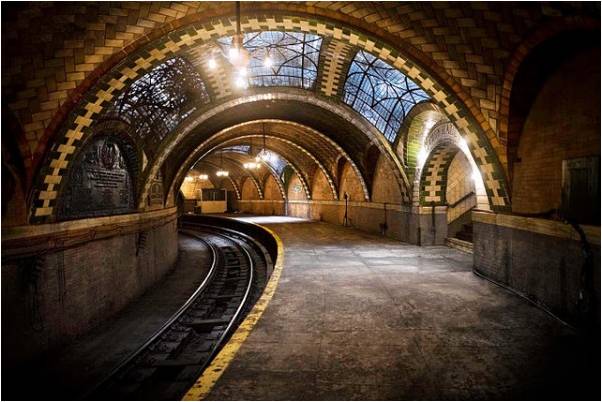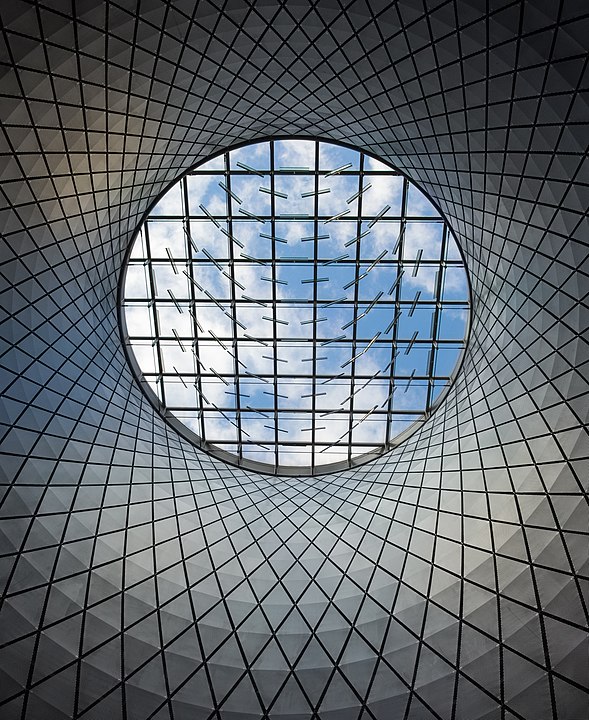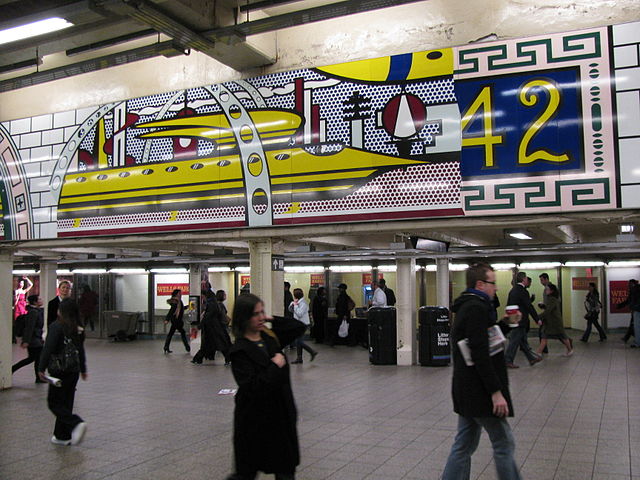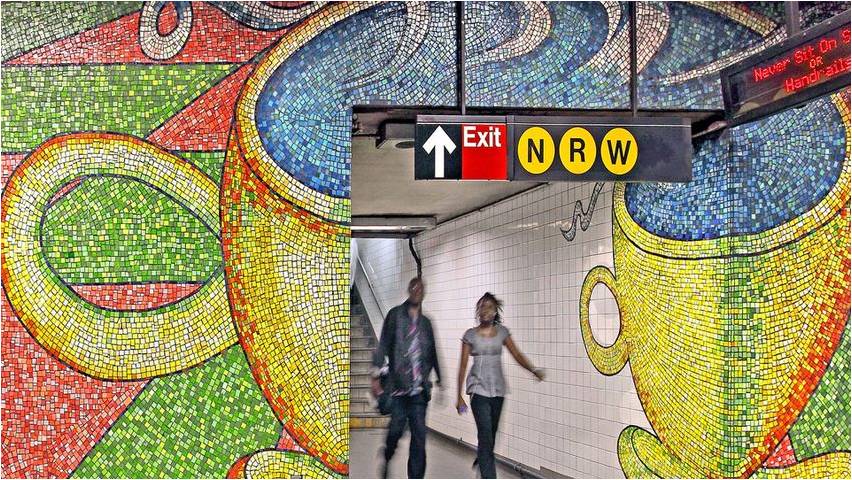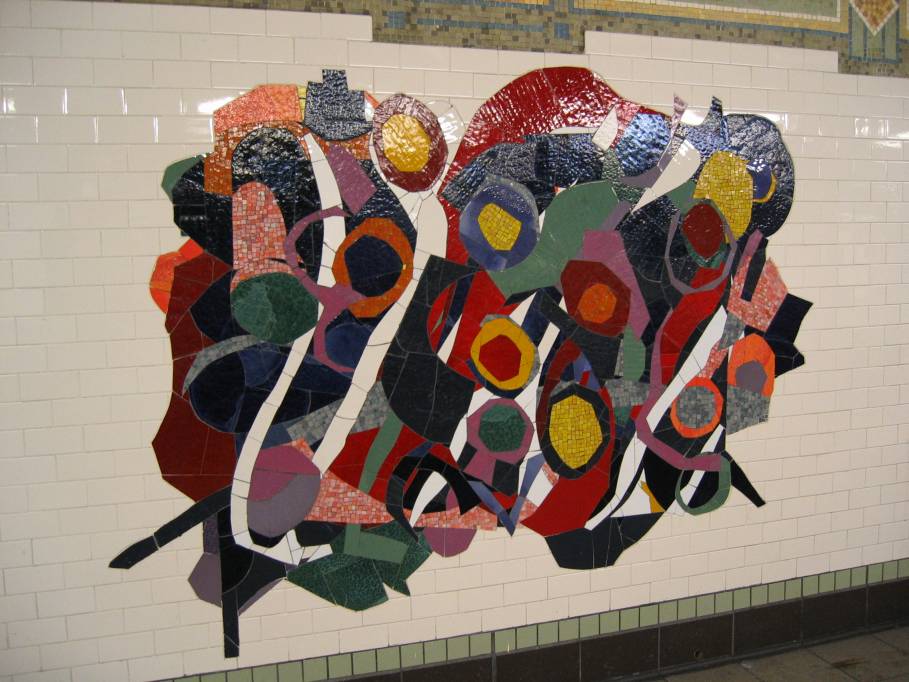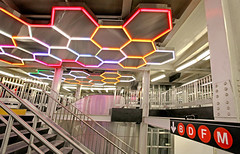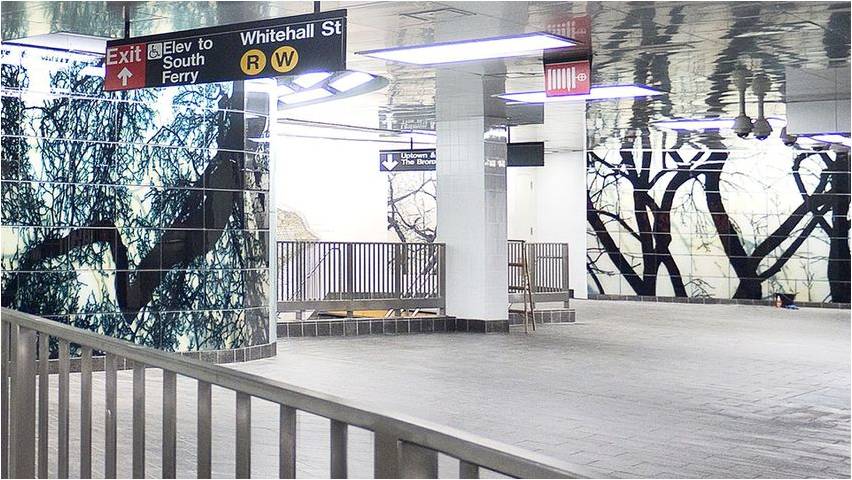NEW YORK’S UNDERGROUND ART MUSEUM: SUBWAY
L’arte, inaspettata e pubblica, nella metropolitana di New York: un museo sotteraraneo aperto a tutti, con opere bellissime e gratuite. L’unico costo è il biglietto della subway! (SpeakUp 365) Potete vedere questo link per averne una rapida panoramica: https://mashable.com/2014/11/11/new-york-city-subway-art/?europe=true#0djvWXCrDOqJ Interessante vedere come un’opera prettamente funzionale e di uso comune come la metropolitana,sia stata reinterpretata in una visione artistica mantenendo però la sua funzione base (e non poteva essere altrimenti). Un’esposizione d’arte gratuita (al prezzo del biglietto) che però è essa stessa pubblicità e manifesto della vitalità della città di New York. Anche altre metropolitane sono di una estrema bellezza, su tutte quella di Mosca, ma là la metropolitana era stata creata con l’obiettivo di essere elegante oltre che funzionale, quella di New York è stata (diciamo così) reinterpretata in un’ottica artistica a partire dal 1985 (si evda più avanti il MTA art and design)
Rilevante è il sito della MTA dove viene illustrata l’offerta con dovizia di particolari e anche con podcast. Cos’è l’ MTA?
The Metropolitan Transportation Authority is North America’s largest transportation network, serving a population of 15.3 million people across a 5,000-square-mile travel area surrounding New York City through Long Island, southeastern New York State, and Connecticut.
The MTA network comprises the nation’s largest bus fleet and more subway and commuter rail cars than all other U.S. transit systems combined. The MTA’s operating agencies are MTA New York City Transit, MTA Bus, Long Island Rail Road, Metro-North Railroad, and MTA Bridges and Tunnels.
The links below provide snapshots of the MTA Network, our agencies’ performance, annual budgets, and our current leadership.
Qua a questo link avete anche podcast e filmati youtube su tutte le offerte artistiche che l’MTA offre quindi non solo quelle limitate alla subway. Il link: http://web.mta.info/mta/aft/podcast/
Sicuramente uno dei più rilevanti opere artistiche, qua diciamo artistiche -archiettoniche, è per me il “Fulton Center” che rientra anche in un contesto di “ristrutturazione” della Lowe manhattan dopo l’11 settembre 2001. È inoltre indicativo dell’arte-architettura del nuovo millennio. Questo è diverso dalle altre fermate metropolitane che vi illustrerò perché se queselle dic ui vi parlerò saranno legate all’arte, da qui il titolo di questo capitolo su New York come la metropolitana in quanto museo d’arte gratuita – questo qua di cui vi sto parlando ora (e a parte da tutto il resto) è in primis un’opera architettonica che però lega archiettura ed arte, come d’altronde sempre è stato. Ma nasce non da una funzione di “abbellimento” ma nasce da una funbzione pratica: una grande stazione metropolitana in cui si intrecciano nove linee (A, C, J, Z, R, 2, 3, 4, 5) tra Fulton Street e Broadway. Questa stazione è (diciamo) completamente nuova ma sorge là dove sorgeva una precednte stazione che a seguito (è d’altronde nello stesso quartiere del World Trade Center) proprio in seguito agli attentati dell’11 settembre 2001 la stazione fu chiusa a causa di alcuni danneggiamenti alla struttura. Grazie a un imponente piano di ristrutturazione, che ha subito anche alcuni rallentamenti, la stazione è diventato un edificio completamente nuovo: un centro con negozi e uffici che si estende per una superficie complessiva di circa 6130 metri quadrati, e cheè funzionale al passaggio e allo smistamento da passaggio per circa 300 mila persone al giorno. Non sono però i negozi o la granmdezza a rendere particolare questa struttura, bensì la struttura archiettonica medesima.
Questo è
Sky Reflector-Net
(2014), James Carpenter Design Associates, Grimshaw Architects and ARUP
This piece, which graces the cover of ‘New York’s Underground Art Museum,’ appears at Manhattan’s redesigned Fulton Street station that opened Nov. 10. Its aluminum panels allow plenty of sunlight to peek through.
Ma al di là di questa eccezione, non unica, di cui vi volevo far partecipi, iniziamo il nostro tour della metropolitana newyorkese che chiameremo con l’espressione tipicamente americana di subway. In fiunzione di ciò prima facciamo una breve introduzione alla metropolitana di New York:
Questa metropolitana non fu la prima aperta a New York, se ne era già aperta una nel 1870, di una sola fermata, e che durò appena 3 anni. Per avere infiormazioni guardatevi questo (in inglese ovviamente …): https://www.history.com/news/the-strange-tale-of-new-yorks-forgotten-subway o anche questo sito: https://www.knowol.com/information/new-york/new-york-citys-pneumatic-subway-hyperloop/
Ma la metropolitana che oggi turisti e newyorkesi sfruttano e ammirano è quella nata nel 1904. ovvero la seguente:
La metropolitana di New York (in lingua inglese americana: New York City Subway) è la rete metropolitana che serve la maggiore città degli Stati Uniti d’America. È una delle più antiche ed estese reti di trasporto pubblico al mondo, con 472 stazioni operative (425 se le stazioni interconnesse vengono considerate come una singola stazione);[1] 380,200 km di tracciato;[2] e un totale di 1 370 km includendo tutti i binari.[3] Nel 2015, la metropolitana ha trasportato oltre 1,762 miliardi di passeggeri, per una media di oltre 5,6 milioni ogni giorno lavorativo, 3,3 milioni il sabato e 2,6 milioni la domenica.[1].
La metropolitana di New York è la quarta al mondo dopo quelle di Tokyo, Mosca e Seul nel conteggio annuale dei passeggeri e trasporta più passeggeri della somma totale di tutte le altre metropolitane degli Stati Uniti. Nella lista delle metropolitane più utilizzate al mondo è l’unica con servizio effettuato 24 ore al giorno, 365 giorni l’anno.[4]
La metropolitana è attualmente sottoposta a lavori di ammodernamento ed espansione. Gli attuali progetti d’espansione includono la Second Avenue Subway nella zona nord di Manhattan, la 7 Subway Extension nella zona ovest di Manhattan e il Fulton Street Transit Center.
Il successo della metropolitana newyorkese è anche dovuto al fatto che Guidare un’auto a New York è probabilmente il sistema di trasporto meno efficiente, a causa dell’alta concentrazione di semafori e traffico veicolare. Questo viene solitamente evidenziato da tutte le guide di New York.
(Questo miglior sito fatto bene ed esplicativo dello sviluppo e premsse della metropolitana di New York, rimandare sicuramente: https://ny.curbed.com/2017/9/20/16305388/nyc-subway-history-mta-train-cars )
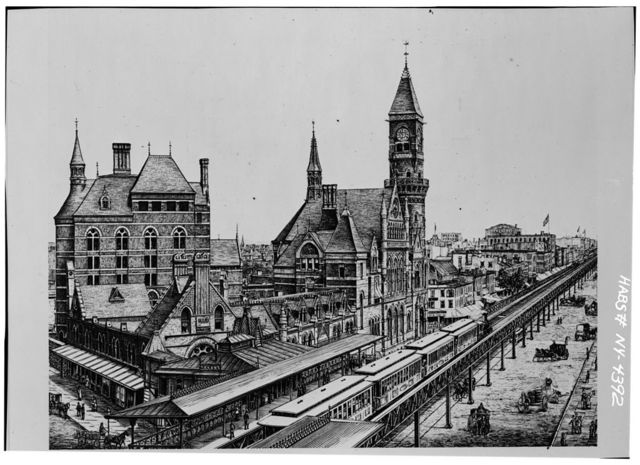
Historic American Buildings Survey, creator
Withers, Frederick Clark
Vaux, Calvert
Cavalieri, Giorgio
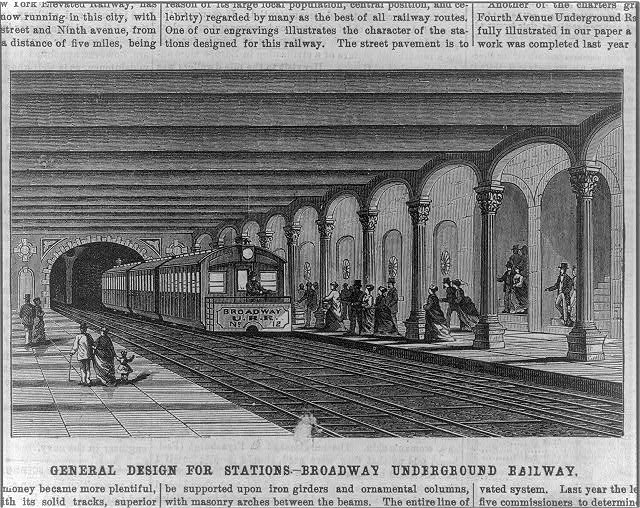
[General design for stations – Broadway Underground Railway]
Created / Published
[1876]
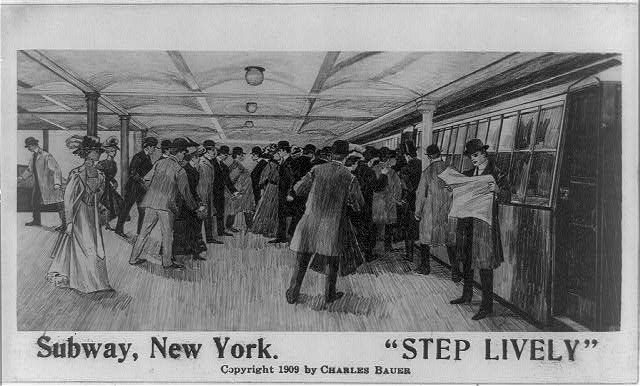
Subway, New York. “Step lively”
Summary
Reproduction of drawing(?) showing busy subway station.
Created / Published
c1909.
DAl Library Congress, un breve filmato storico sulla “excavation della metropolitana https://www.loc.gov/item/2016600203/
La metropolitana di New York (metro) è il mezzo di trasporto più usato dai newyorkesi. E’ un modo semplice e sicuro per raggiungere ogni angolo della città. E’ aperta 24 ore su 24, 7 giorni su 7, tutto l’anno. Con la MetroCard una corsa singola costa 2.75 $ e quindi uno dei modi più economici per esplorare la città.
New York Trains
I newyorkesi chiamano le tratte della metro train. La metropolitana di New York ha 468 stazioni e 24 tratte diverse. Le linee sono identificate dalle lettere A, B, C etc. a da numeri 1, 2, 3 etc. Queste tratte servono il Bronx, Manhattan, Brooklyn e il Queens.
La frequenza dei treni va da 2 a 5 minuti nelle ore di punta, da 10 a 15 minuti di giorno e ogni 20 minuti di notte. Le ore di punta nei giorni feriali sono tra le 7:30-9:30 e 16:30-18:30. Di notte è consigliato prendere un taxi soprattutto se si viaggia da soli in direzione di/da altri distretti della città.
Un sistema di trasporto metropolitano a New York venne costruito inizialmente da Alfred Ely Beach nel 1869. Il suo Beach Pneumatic Transit era esteso soltanto 95 m sotto Broadway e mostrava la sua idea di metropolitana. Il tunnel non venne mai esteso, il progetto di estensione proponeva di ampliare il tunnel verso Battery Park a sud e verso il fiume Harlem a nord.[9] Venne demolito quando venne costruita la BMT Broadway Line negli anni dieci del XX secolo.
La prima linea della metropolitana aprì il 27 ottobre del 1904, quasi 35 anni dopo l’apertura della prima linea ferroviaria sopraelevata di New York, che divenne la linea IRT Ninth Avenue. La pesante tempesta di neve del 1888 aiutò a dimostrare i benefici di un servizio di trasporto sotterraneo. La struttura più vecchia, ancora in uso oggi, aprì nel 1885 come parte della linea BMT Lexington Avenue, ed è oggi parte della linea BMT Jamaica a Brooklyn. La linea più antica in superficie, attualmente parte della linea BMT West End, fu aperta nel 1863 come ferrovia a vapore chiamata Brooklyn, Bath and Coney Island Rail Road. La linea ferroviaria Staten Island, che venne aperta nel 1860, attualmente utilizza treni di tipo R44, ma non ha collegamenti con il resto del sistema e non è solitamente considerata come parte della linea metropolitana.
Quando la prima linea metropolitana aprì, le linee si erano consolidate come due compagnie private separate, la Brooklyn Rapid Transit Company (BRT, successivamente Brooklyn-Manhattan Transit Corporation, BMT) e la Interborough Rapid Transit Company (IRT). La città era coinvolta da vicino: tutte le linee costruite per la IRT e la maggior parte delle linee costruite o migliorate dopo il 1913 per BRT vennero costruite dalla città ed affidate alle compagnie. La prima linea costruita e controllata dalla città tramite l’Independent Subway System (IND) aprì nel 1932; questo sistema venne progettato con l’intento di competere con i sistemi privati e permettere l’eliminazione di alcune linee ferroviarie non sotterranee, ma si limitò al centro cittadino a causa della scarsa quantità di capitali iniziali forniti dal ministero dei trasporti statale. Questo comportò il dover avere un costo doppio rispetto alla tariffa standard del momento di 5 centesimi.[10]
Nel 1940 i due sistemi privati vennero acquistati dalla città; alcune linee sopraelevate vennero chiuse subito, altre poco dopo. L’integrazione fu lenta, ma molte interconnessioni vennero costruite tra l’IND e il BMT e attualmente operano come una sola divisione chiamata B Division.
Tra parentesi questa metropolitana è in continua estensione, proprio il mese scorso è stata aperta una nuova tratta (attesa):
2 GENNAIO 2017
Le foto della nuova metropolitana di New York
Domenica sono state aperte le prime tre fermate della Second Avenue Subway, l’attesa estensione della linea Q che arriva fino all’Upper East Side
Tour delle fermate (più significative da un punto di vista artistico): Millions of New Yorkers and tourists travel on – or ride – the subway every day. The public transportsystem offers more than just a journey, however. It also has one of the most extensive public art collections in the world, with much of it under the city streets.
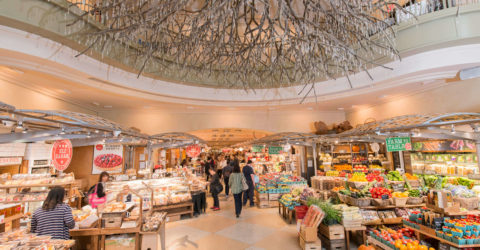
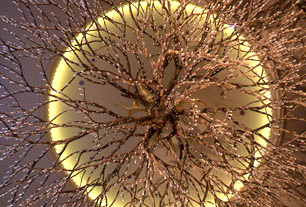
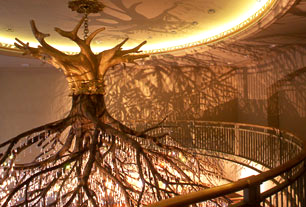
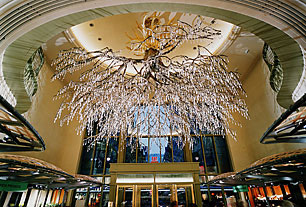
DONALD LIPSKI
Sirshasana, 1998
Aluminum and polyester resin sculpture with crystals in ceiling at 43rd Street in Grand Central Market
nelle immagini sopra siamo a Grand Central Station (e da dove si poteva partire?) e quello è il gran candeliere sopra il Grand central Market
MTA:
MTA Arts & Design
MTA Arts & Design, formerly known as Arts for Transit and Urban Design,[1] is a commissioned art program directed by the Metropolitan Transportation Authority for the transportation systems serving New York City and the surrounding region. Since its inception in 1985, the program has installed art in over 260 transit stations.[2] The art is intended to be site-specific with an overall goal of enhancing the journey for New Yorkers and visitors alike.
MTA Arts & Design has works commissioned by over 300 artists, with entries in graphic art, photography installations, digital art, Music Under New York, Poetry in Motion, and special events.
When the New York City Subway opened in 1904, its founders declared that the railway was a “great public work” where every design element should show respect for customers and enhance the experience of travel through beauty and efficiency.[3] MTA Arts & Design was created in 1985 when the MTA began to address years of decline by rehabilitating and renewing the transit system.[2]
The commissioning of original artwork was part of the rebuilding, signaling to customers that the system considers riders’ comfort and experience within stations. Works use durable materials like ceramic tile and mosaic, bronze, stainless steel, glass and light. MTA Arts & Design also plays an important role in design elements and architecture within passenger stations as well as industrial design elements and subway car design.
The Percent for Art projects link people to places with art that echoes the architectural or cultural history, urban design and community context of stations. The identity of New York City and its subway system is connected to the permanent artwork in the stations. The collection of work serves as the city’s underground art museum and represents its vitality, energy and diversity.[4] Most of the art is site-specific.[5][6]
Artists are chosen through a competitive process with selection panels composed of visual-arts professionals. They review artists’ previous work, choose finalists who produce site-specific proposals, and then reconvene to select artist proposals for the given project(s). Community representatives are invited to attend the meetings and provide input. Artist opportunities are posted on the A&D website and announced through social media and local arts organizations
Notable artists commissioned through the program include Xenobia Bailey, Romare Bearden, Vito Acconci, Jacob Lawrence, Ellen Harvey, Sol LeWitt, Roy Lichtenstein, Elizabeth Murray, Faith Ringgold, Duke Riley, Shinique Smith, Nancy Spero, Doug and Mike Starn.[8]
The January 1, 2017 opening of the Second Avenue Subway Phase 1 stations (72nd Street, 86th Street, and 96th Street as well as new renovation of Lexington Avenue–63rd Street) added permanent installations by Vik Muniz, Chuck Close, Sarah Sze, and Jean Shin to the Arts & Design collection.[9]
More than 100 new projects are underway, including Ann Hamilton‘s artwork for the new Cortlandt Street station.[10] Another notable work, Sky Reflector-Net, was installed in 2014 in the then-new Fulton Center headhouse. It uses hundreds of aluminum mirrors to provide natural sunlight from a 53-foot skylight to an underground area as much as four stories deep.[11] This is the first intentional skylight in the New York City Subway system since the 1945 closure of the original City Hall statio
nyc. manhattan. art underground
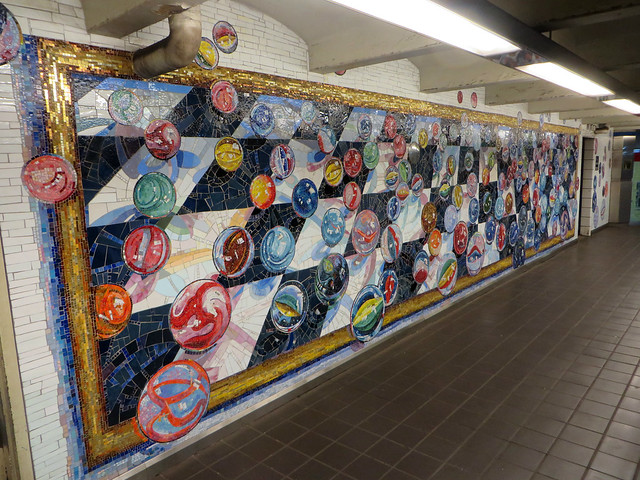
Lisa Dinhofer’s “losing my marbles” (2003) at the 42nd street/port authority bus terminal subway station. Art by Lisa Dinhofer in the Times Square subway station
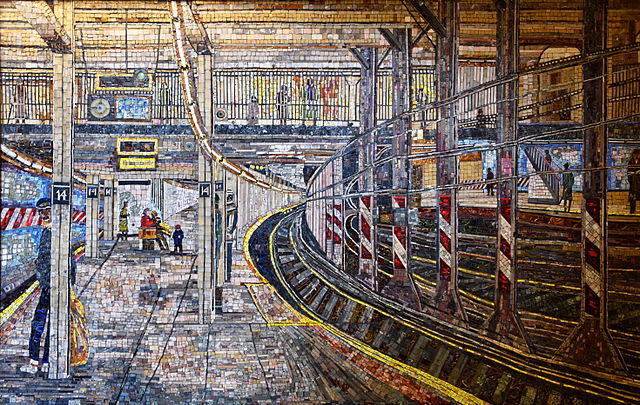
mosaic by edith kramer titled “new york subway station” . Mosaic by Edith Kramer titled New York City Subway Station at the uptown entrance to the IND Eighth Avenue Line at Spring Street depicting the IRT Lexington Avenue Line platform at 14th Street – Union Square
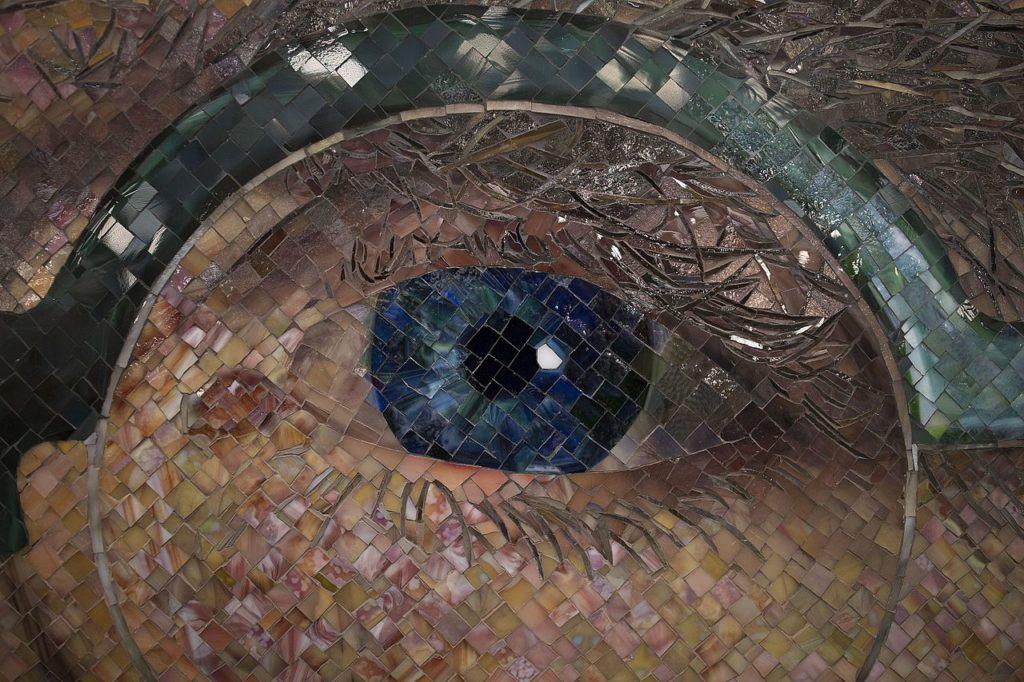
In 2009, MTA Arts & Design selected Chuck Close from a pool of 300 potential artists to create the artwork for the station.[51] His work consists of a series of twelve portraits of the city’s cultural figures,[52] spread over 1,000 square feet (93 m2) of wall.[53][54] Each 10-foot-high (3.0 m) piece is made with tiles that are painted to create a mosaic-like effect.[55] The pieces cost $1 million and were installed near the exits and in the mezzanines.[55]
Close’s portraits at the station, titled “Subway Portraits,” fall into two main categories.[51] The first category of portraits comprises artists whom Close is familiar with. The station contains portraits of composer Philip Glass in his youth; musician Lou Reed; photographer Cindy Sherman; painter Cecily Brown; artist Kara Walker; and painter Alex Katz.[51] The second category is composed of portraits of younger, more ethnically diverse artists including Zhang Huan, Sienna Shields and Pozsi B. Kolor.[51] In these portraits, Close aimed to highlight the cultural diversity of New York City.[51] He also has two self-portraits within the station.[51]
E’ interessante vedere come lo stesso percorso per arrivare in metropolitano al museo può essere vissuto come un’introduzione ad esso attraverso un’opera d’arte. Di modo da essere maggiormente attrattivo anche per turistica.
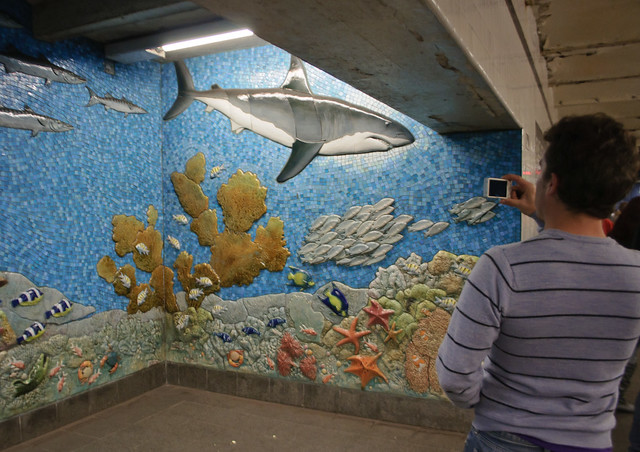
the 81st street subway station on the upper west side gives you a taste of what to expect at street level: the museum of natural history.
This is the lower (southbound) platform for the 81st Street Station on the B and C subway lines, running along Central Park West. This subway station serves the American Museum of Natural History. This stairway, which leads directly to/from the museum basement, is appropriately decorated with a nature mosaic – in this case, an undersea scene. The upper (northbound) platform is directly at the museum basement level.
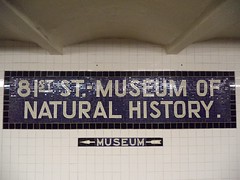
Per esempio le fotografie sotto sono state prese da: are the stairs leading down to a mosaic aquarium. È tutto il percorso della metropolitana da fare a piedi che conduce al museo, è tutto decorato con motivi che ovviamente richiamano il American Museum of Natural History
Abbiamo poi il grande mosaico di Jacob Lawrence nella fermata di Times Square, esattamente a Glass mosaics on stairway wall between N, Q, W, R and S mezzanines. Vi metto una presentazione su youtube anche perché le foto che trovo sono tutte protette da diritti di copyright.
The enormous mosaic mural is the focal point of the mezzanine in the Times Square subway complex. Its shimmering and detailed surface pays tribute to the diversity and strength of New York City – its neighborhoods, cultural life, recreational pleasures, love of sports and, of course, its subway. In it hLawrence evokes city life seen from an elevated train and the sensitive and loving portrait shows a slice of city life and is a parting gift to New York City, seen by millions of people who live and visit here.
Sempre a Times Square troviamo:
Times Square Mural
(2002), Roy Lichtenstein
The Times Square – 42nd Street station is home to this masterpiece, which reflects on the future and the past, as well as the artist’s own portfolio. The train-like transporter and several other elements are reminiscent of some of Lichtenstein’s previous pieces.
Blooming (1996), Elizabeth Murray
Blooming lines a portion of the walls at the Lexington Avenue – 59th Street station from top to bottom. New York’s Underground Art Museum explains how Murray’s work pays homage to the subway designers who wanted to showcase people’s positive qualities through art, and represents her view of the subway as a “dreamy underworld.”
In Everything There Is a Season(2005), Robert Blackburn
Often recognized for his abstract color lithographs, Blackburn created this piece that appears in the 116th Street train station. It was his final big venture before his death, and Mei-Tei-Sing, a fellow within the Printmaking Workshop he started, helped him finish this work.
Hive (2012), Leo Villareal
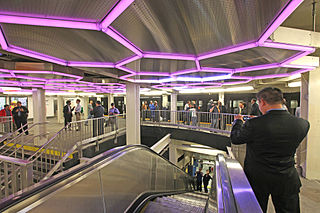
Metropolitan Transportation Authority of New York (Rob Wilson)
This recent addition to the Bleecker Street station is Villareal’s take on the hustle and bustle that we associate with New York City. The artist frequently uses codes and LEDs in his work like the electric hexagonal tubes shown here.
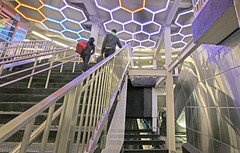
See It Split, See It Change (2009), Doug and Mike Starn
Stone mosaic, glass and stainless steel trees cover the South Ferry station’s walls in this work created by identical twin brothers. A map of Manhattan is also included in the piece, suggesting a connection between nature and New York City.
Non la faccio più lunga di quanto gioà fatto però vorrei che vi soffermaste un attimo a pensare su quan to ha detto la direttrice del MTA. Questa costruzione/ricostruzione in chiave “artistica” della metropolitana non èp casuale e non è buttata a caso. La metropolitana nasce come un’opera funzionale, un pò come qualsiasi opera funzionale deve soddisfare un’esigenza umana di “bello” o se volete di “elevazione”. Vale da sempre e senza scomodare il partyenone si potrebbero citare anche le idrovore di Rovigo l cui monumentalità rispondeva allo stesso criterio a cui rispondeva la monumentalità di Notre Dame de Paris. ma su questo non voglio allungarmi. leggete solo questa frase della prima direttrice del MTA’arts program:
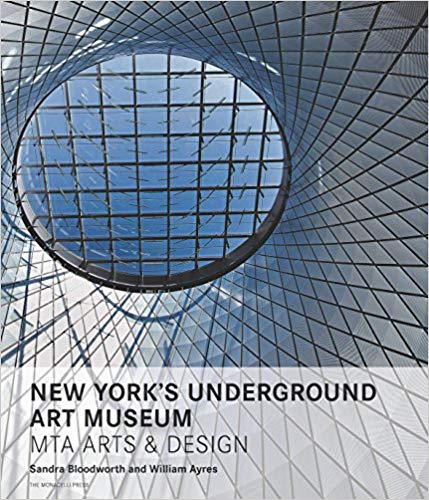
Sandra Bloodworth has directed the Metropolitan Transportation Authority’s arts program since it began in 1985. She says that “It really began much earlier. When the subway was founded in 1904, part of the money was used to create a very special place that people would want to use.”
Questo è quanto si può vedere nella metropolitana di New York, ma interessante è anche ciò che non si vede. come sempre. Considerate che la Metropolitana di New York è una delle più antiche ed ancora in uso metropolitane al mondo. Di conseguenza non potevano mancare quindi stazioni ormai chiuse, abbandonate a se stesse e feconde di leggende metropolitane. A questo link trovate alcuni riferimenti. Notare anche la diversità architettonica nelle varie decadi. Per certe fermat abbandonate ci sono degli speciali tour per altre dovrete accontentarvi della fantasia, gran ricchezza per voi e per chi lavora nel turismo.
Per i curiosi ( e per i “creepy”) guardatevi: https://www.thrillist.com/lifestyle/new-york/nycs-most-insane-abandoned-subway-stations e poi: https://www.catinwater.com/artistic_inspirations/abandoned-subway-station-in-new-york-city-an-underground-art-gallery/
Un’immagine per invogliarvi a vedere i due link:
